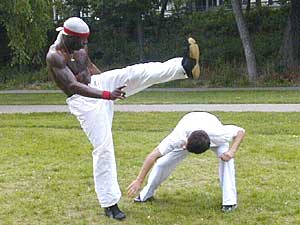|
Audio
Photos
Resources
Your Voice
|
A fight with style
August 3, 2004
 |
| Two capoeiristas practice their moves at a recent session in Minneapolis. (MPR Photo/Annie Feidt) |
Minneapolis, Minn. — On an unbearably hot and humid evening, about 20 people are gathered in a group beside Lake Calhoun, sweating like mad. They form a circle, called a roda, on a mosquito-infested swath of grass, and watch as two people spar in the middle. Capoeira newcomer Ben Portwood says the game begins with music.
"The two people meander their way over, and they look each other in the eye, shake each other's hands and then stand up and go into a cartwheel into the roda and then start playing," says Portwood.
 | |||
The two people "playing" in the center of the roda launch attack after attack. They go at each other with spinning kicks, vaulting handstands and even flips, but they rarely actually touch.
Jonathan Will has been practicing capoeira for more than three years. He says the object is to force your opponent to lose their balance, and he says the games are not as gentle as they look.
"It's kind of trickery to the person that's viewing it because it looks so fluid. Well, that's deceitful. You're actually trying to open up your game so the other person lets their guard down," Will explains. "You're always showing the other person that you could have hit them in the chest, that you could have taken them down but you chose not to."
No one can say for sure how or where capoeira got its start. The most popular account is that African slaves in Brazil developed the martial art about 400 years ago. They disguised the fighting as a dance so their slave masters wouldn't ban it. The Brazilian government did ban capoeira in 1892, but legalized the sport again in the 1930s. It's now taught in schools and universities across Brazil.
 | |||
Yoji Senna is a capoeira master in Minneapolis. He was born and raised in Bahia, the region in Brazil where most people believe the sport was born. His father was a Brazilian capoeira master who developed the sport's first belt system.
He says capoeira started catching on outside of Brazil in the early 1970s, and has spread quickly around the world.
"In Siberia for example, there is a capoeira group, and in Europe it's popular," says Senna. "In the last 30 years, capoeira has bloomed. You find it in Japan, Singapore, Dubai, Iceland. In the most desperate places, you find people who practice capoiera."
At the YWCA in uptown Minneapolis, a group of 6-year-olds is working hard to grasp some capoiera fundamentals.
 | |||
Rebecca Harvala is a former student of Senna's, who's been teaching capoeira to young kids for more than two years. She says it's a great activity for kids because it combines so many disciplines -- athletics, music and culture. And she says parents have been quick to catch on to the possibilities.
"In 1991, hardly anyone knew what capoeira was, and now people are seeking it out," says Harvala. "Parents know about it. They say, 'Hey, I saw on Sesame Street something about capoeira, or I saw it on cable.' So now people are coming and asking me about capoeira."
Harvala says capoeira is male-dominated, and she likes the fact that her classes attract mostly girls.
"I like to teach capoeira as a sport to women because it brings out more of their competitive side, it brings out their fiesty side. It brings out a little bit more of their fight, which a lot of women hold back," she says.
 | |||
Harvala currently teaches capoeira as a hobby, but she says she's had enough interest from schools, community groups and parents to easily turn it into a full-time job. Still, she worries about the sport's growth.
"It's important that capoiera maintains its traditions, that the cultural aspects don't become filtered out as it grows as a sport. People should still understand the history. They should respect the roots and the etiquette and the people who have come before them," says Harvala.
Capoiera master Yoji Senna insists his students stay in touch with the roots of capoeira, by writing papers on the sport's history and culture. The students seem eager to deliver. Most participants say they view capoeira as more of a lifestyle than a sport.
Nora Hoehn was a professional volleyball player in Germany. But she says Senna has made her a capoeira convert.
"It's not only that you do the sport. That's what I didn't like so much in volleyball. It was just a sport. And here it's like it has background, history -- and it's really fun."
Hoen says she's heading back to Germany soon. But she won't give up capoeira. She's already found a local club where she can spar.
|
News Headlines
|
Related Subjects
|
